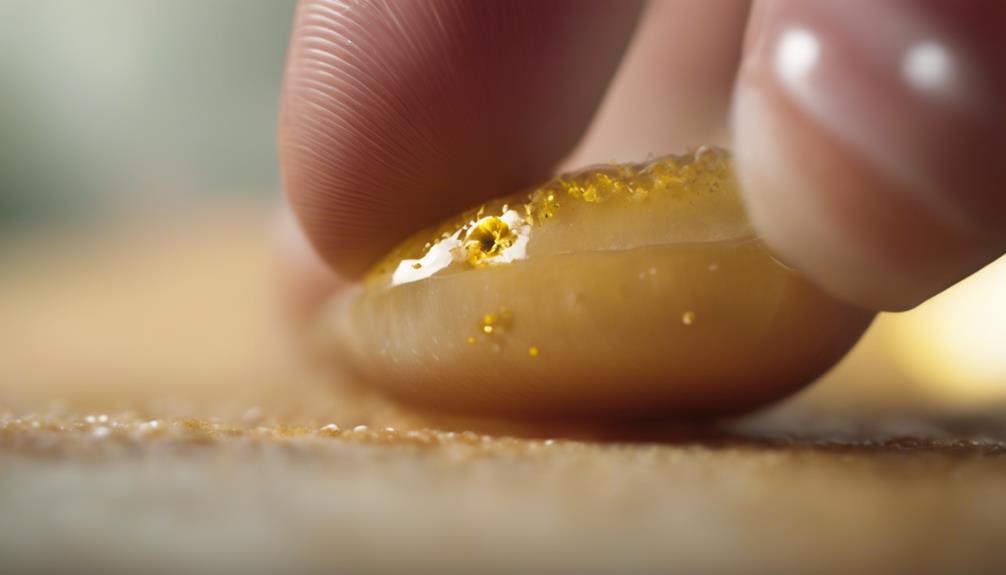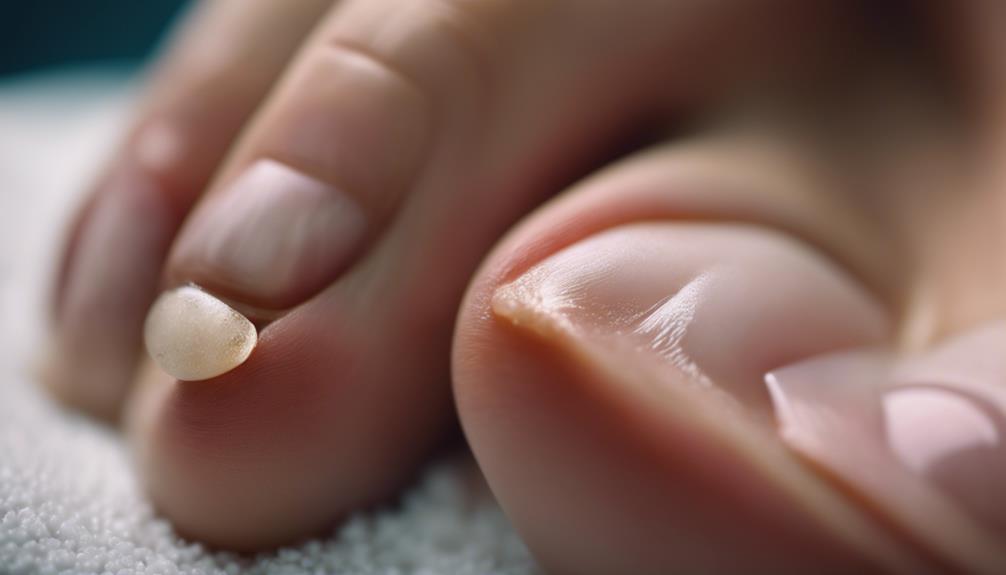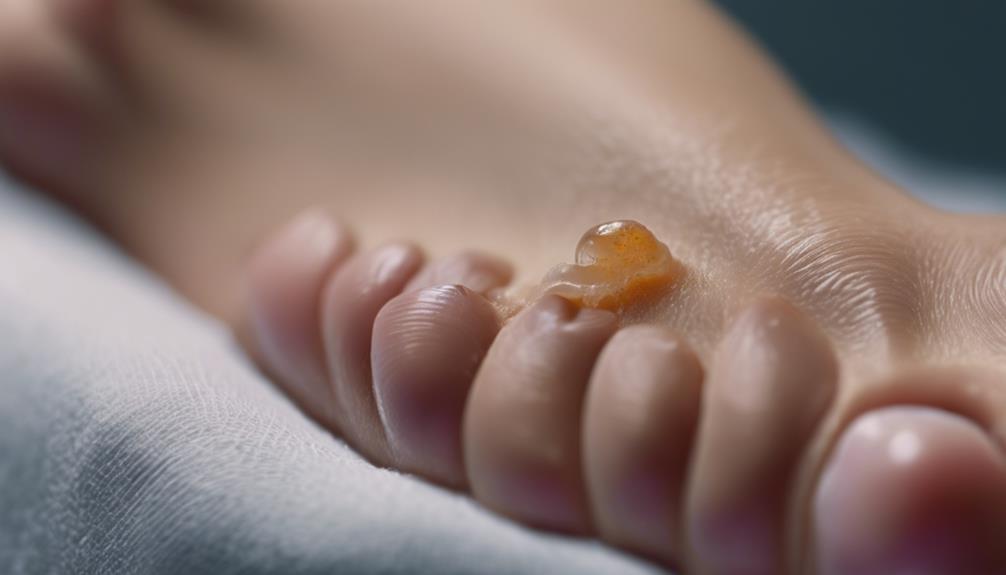Is Toenail Fungus Under the Nail?

Toenail fungus primarily develops under the nail, posing a challenge for treatment due to its location. The warm and moist environment under the nail provides a breeding ground for fungal growth. Symptoms like discoloration, thickening, and brittleness are common indicators of nail fungus. Prevention involves maintaining proper foot hygiene, wearing breathable footwear, and avoiding public areas barefoot. Various treatment options such as topical or oral antifungal medications, laser therapy, or surgical nail removal can be tailored based on the severity of the infection. Understanding the signs, symptoms, and treatment can help in addressing toenail fungus effectively.
Key Takeaways
- Toenail fungus can develop underneath the nail itself, thriving in warm, moist environments.
- Fungi growth is common between the nail and nail bed, making it a breeding ground for infections.
- Symptoms of nail fungus include discoloration, thickening, and brittleness of nails.
- Treatment options for nail fungus range from topical and oral medications to laser therapy.
- Prevention involves proper foot hygiene, breathable footwear, and avoiding walking barefoot in public areas.
Location of Toenail Fungus

Toenail fungus typically thrives in warm, moist environments under the nail where proper ventilation is limited. This dark and damp setting provides an ideal breeding ground for fungal growth, making toenails particularly susceptible to infection. When left untreated, the fungus can spread deeper into the nail bed, potentially causing discomfort and aesthetic concerns for individuals. It is crucial for individuals to be aware of the common locations where toenail fungus can develop, such as between the nail and the nail bed, as well as underneath the nail itself.
Understanding the location of toenail fungus is essential for effective treatment and prevention strategies. Proper hygiene practices, wearing breathable footwear, and keeping feet clean and dry can help mitigate the risk of fungal infections. For individuals providing care to those with toenail fungus, recognizing the typical location of the infection can aid in early detection and prompt intervention to prevent further complications. By addressing the location of toenail fungus proactively, individuals can work towards maintaining healthy feet and nails.
Understanding Nail Fungus Growth
In the realm of dermatology, a comprehensive understanding of nail fungus growth is pivotal for effectively addressing this common ailment. Nail fungus, also known as onychomycosis, is a fungal infection that affects the nails on the fingers and toes. Here are some key points to consider when trying to understand nail fungus growth:
- Causes: Fungi thrive in warm, moist environments, making sweaty shoes and damp areas common culprits for infection.
- Symptoms: Look out for discoloration, thickening, or brittleness of the nails, as these are common signs of nail fungus.
- Risk Factors: Individuals with weakened immune systems, diabetes, or a history of athlete's foot are more susceptible to nail fungus.
- Prevention: Proper foot hygiene, wearing breathable footwear, and avoiding walking barefoot in public areas can help prevent nail fungus growth.
Signs of Nail Fungus Infection

A common indicator of nail fungus infection includes noticeable changes in the color and texture of the affected nails. When a nail becomes infected with fungus, it may appear yellow, brown, or white. The nail may also thicken, become brittle, and develop crumbling edges. In some cases, the affected nail may emit a foul odor. Additionally, individuals with nail fungus infection may experience discomfort or pain around the affected nail.
Another sign of nail fungus infection is the presence of debris under the nail. As the infection progresses, the nail may detach from the nail bed, causing a gap where debris can accumulate. This debris may consist of skin cells, nail fragments, and fungus itself, contributing to a further deterioration of the nail's appearance and health.
If you notice any of these signs or symptoms, it is essential to seek medical advice promptly. Early detection and treatment of nail fungus infection can help prevent the spread of the infection and promote faster recovery.
Treatment Options for Nail Fungus
When addressing nail fungus, various treatment options are available to effectively manage and eradicate the infection. It is essential to consider the severity of the infection and individual health factors when determining the most suitable treatment plan. Here are some common treatment options for nail fungus:
- Topical Antifungal Medications:
- These medications are applied directly to the affected nail and surrounding skin to target the fungus.
- Oral Antifungal Medications:
- Prescription oral medications may be prescribed for severe cases of nail fungus that do not respond to topical treatments.
- Laser Therapy:
- Laser treatment can be used to target and destroy the fungus that causes nail infections.
- Surgical Nail Removal:
- In cases where the infection is severe or causing significant pain, surgical removal of the nail may be necessary to allow for the application of antifungal medication directly to the nail bed.
Consulting with a healthcare professional can help determine the most appropriate treatment based on individual circumstances and the extent of the nail fungus infection.
Preventing Nail Fungus Spread

To effectively prevent the spread of nail fungus, implementing proper foot hygiene practices is crucial. Keeping feet clean and dry, especially between the toes, can help reduce the risk of fungal growth. It is important to wash the feet daily with soap and water, ensuring to thoroughly dry them afterward, as fungi thrive in moist environments. Wearing clean socks made of breathable materials like cotton or moisture-wicking fabrics can also aid in preventing the spread of nail fungus. Additionally, regularly changing socks and shoes, and allowing footwear to air out between uses, can further decrease the likelihood of fungal infections. Avoiding walking barefoot in public areas such as locker rooms, showers, and swimming pools can also lower the risk of coming into contact with the fungus. By practicing good foot hygiene and taking preventive measures, individuals can help safeguard themselves and others from the spread of nail fungus.
Seeking Professional Help for Nail Fungus
When dealing with toenail fungus under the nail, seeking professional help is crucial for effective treatment. Professionals can provide accurate diagnosis and recommend appropriate treatment options tailored to the severity of the infection. Understanding the importance of early intervention and the various treatment methods available is key to successfully combating nail fungus.
Importance of Treatment
Seeking professional help for nail fungus is crucial to effectively address the infection and prevent potential complications. Nail fungus, if left untreated, can lead to more severe issues. Here are some reasons why seeking professional assistance is important:
- Accurate Diagnosis: Healthcare providers can properly diagnose the type and severity of the nail fungus.
- Tailored Treatment Plan: Professionals can create a personalized treatment plan based on individual needs.
- Monitoring Progress: Regular check-ups allow for monitoring the progress of the treatment.
- Preventing Recurrence: Professionals can provide guidance on how to prevent the recurrence of nail fungus in the future.
Treatment Options Available
Professional treatment for toenail fungus involves a range of effective options tailored to address the infection under the nail. When seeking assistance for nail fungus, individuals can benefit from consulting with a podiatrist or dermatologist. These specialists can accurately diagnose the condition and recommend appropriate treatments based on the severity of the infection. Common treatment options may include antifungal medications, topical creams, nail lacquers, or in more severe cases, laser therapy or surgical intervention to remove the infected nail. Professionals in the field of podiatry or dermatology are equipped with the knowledge and tools necessary to provide comprehensive care for individuals dealing with toenail fungus. Seeking their expertise can lead to successful outcomes and healthier nails.
Frequently Asked Questions
Can Toenail Fungus Cause Pain or Discomfort?
Toenail fungus can indeed cause pain or discomfort as it progresses. Symptoms may include thickened nails, discoloration, crumbling edges, and a foul odor. Seeking prompt medical attention can help manage the condition and alleviate discomfort.
Is It Possible to Prevent Toenail Fungus With Home Remedies?
Preventing toenail fungus with home remedies is possible by maintaining good foot hygiene, keeping nails trimmed, wearing breathable shoes, and avoiding walking barefoot in public areas. Consult a healthcare provider for persistent or severe cases.
How Long Does It Take to Completely Get Rid of Toenail Fungus?
Treatment duration for toenail fungus can vary depending on the severity and chosen method. It may take several weeks to months to completely eliminate the fungus. Consistent use of prescribed medications and proper foot care are essential for successful outcomes.
Are There Any Natural Remedies That Effectively Treat Toenail Fungus?
Natural remedies like tea tree oil, vinegar, and coconut oil have shown potential in treating toenail fungus. However, their effectiveness may vary. Consult a healthcare provider for proper diagnosis and guidance on safe and effective treatment options.
Can Toenail Fungus Spread to Other Parts of the Body?
Toenail fungus can indeed spread to other parts of the body if left untreated. This can happen through direct contact with infected nails or skin. Proper hygiene, early treatment, and avoiding sharing personal items can help prevent its spread.




